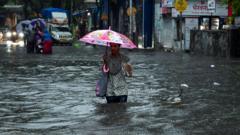India's monsoon season, which typically runs from June to September, brings not only essential rainfall for agriculture but also frequent flooding in major cities. Last month, Mumbai, India's financial hub, faced intense rainfall that overwhelmed its infrastructure, stranding thousands and sparking social media outrage. The Brihanmumbai Municipal Corporation (BMC) pointed fingers at garbage-blocked drains and construction debris, prompting a late response involving de-watering pumps and drain cleaning efforts that left many residents dissatisfied.
This annual flooding is not confined to Mumbai; cities across the country, including Delhi and Bengaluru, experience similar crises. Experts attribute these urban disasters to rapid urbanization, inadequate infrastructure, and environmental degradation. Dikshu Kukreja, an urban planner, emphasizes that the expansion of cities has far outstripped the development of essential drainage systems, and neglect of natural water bodies further exacerbates flooding issues.
Delhi's infrastructure routinely fails during heavy rains, exemplified by the Minto bridge, which annually traps vehicles and highlights the city's struggle with flooding. Earlier this year, Delhi witnessed its wettest May since 1901, leading to property damage and fatalities. Likewise, Bengaluru’s flooding crisis stems from encroachment on its natural lakes, which historically managed excess rainwater. Activists note that regulatory violations and urban development in flood-sensitive zones have transformed once-resilient cities into flood-prone areas.
Geographical realities complicate Mumbai’s situation, as low-lying coastal areas are more susceptible to flooding from heavy rainfall and high tides. Human actions, such as mangrove deforestation and construction in floodplains, have worsened the problem. Experts argue that a comprehensive and forward-thinking approach is necessary for effective flood management. Long-term strategies including advanced mapping technologies, real-time alerts, and community engagement can facilitate better urban planning and resilience.
The annual flood crisis is not limited to metropolitan areas; smaller towns also face significant challenges. Recently, devastating rains in northeastern India resulted in fatalities and widespread displacement. The solution to frequent flooding lies in systemic changes: investing in robust infrastructure, adopting pro-active governance, and fostering community involvement in disaster planning. For Indian cities to develop resilience against monsoon rains, their leaders must prioritize sustainable urban strategies over reactive measures.





















